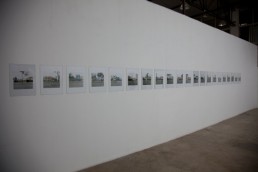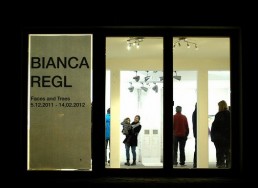How Lonely Does It Get? / Curated by Frederik Foert / Blackbridge Offspace
The artist is a lonely wolf. There are indeed those who are extroverted and those who are introverted, but when it comes to the actual process of creating, everybody stands on their own. Pack or not, you have to stay in the picture.
Whether you love it or you hate it, the artist's solitude in front of the blank piece of paper or the white canvas is a challenge you have to face all by yourself. Romantically transfigured by the outside anyways, suffering for ideas in the ivory tower is every creative thought's origin. Up there the artist is fighting with himself and the dark matters of creation, ruffling hair, discarding and crumpling paper and eventually catching himself in the act; momentarily understanding the beauty of exactly this process. The flash of genius, the successful throw; ? he steps back, lights a cigarette and considers his work proudly. "PloP-Zisch"!
The first reward may be the only one. No one can share this moment, detached from later public situations; the artist, at this point, is completely on his own. A narrative moment which illustrates the melancholy of the working situation as well as their perfect self-sufficiency unite the work selected for this exhibition - video, painting, drawing and installation. Regardless of the public and the art market - lonely at the top ? and then, with a wink, back into the circus! ? Or maybe just ride a little longer into the sunset?
No 11 / Curated by Anna Hofbauer / Blackbridge Offspace
To take a photograph of an object or a specific site confirms not only the existence of itself, but also of its maker/s. In that way photography seems to be a practice of self-affirmation of the human kind. Something comforting lies in the idea of us having been here before, being here now and going to be here in the future. Photography can calm us down through providing evidence of our being by images.
The 3 vessels photographed in black and white by Anja Ronacher are white-ground Lekythoi. They are a special kind of pottery that had been used in funerary rites in antique Greece. The photograph of the Lekythoi is taken in today’s arrangement of display at the Art History Museum of Vienna.
The street-views of Avenida Bolivar photographed in colour by Hannes Boeck show houses representative for the building activity in Lima in a modified style of European Modernist Architecture practiced as from the 1950ies.
Both artists work in analogue techniques and handle the procedure of the enlargements in the darkroom themselves. In charge of all aspects of the reproduction process they are providing evidence in the utmost individual perspective and interpretation of course. Existence is proofed as well as that there is no inherent truth in an object or architectural style itself, but a meaning and purpose in the way of using them - or photographing them. Thus exposing practices of self-affirmation of the human kind at different times and places.
Self Preservation Society / Curated by Xie Molin / Blackbridge Offspace
In this exhibition we will show paintings by Wang Yifan and Zhou Jingsi. Both artists are friends of mine since we were 15 years old and in high school.
Wang Yifan couldn’t care less about anything at one stage in his life; and Zhou Jingsi is a character straight out of the animations. Both of them had at one time loved to paint, and had also abandoned painting due to misunderstandings between them and their work. These past couple of years, they have re-structured their lives around painting again. One could even say that after strolling away from their initial ambition, they have returned to their primordial starting points.
They are now rejoined with their canvases and focusing on their inner feelings and needs, working in patience and tranquility. They paint at their own pace, without talk of innovations, -isms or concepts. This apparent withdrawal is in fact a precisely elaborated tempo developed throughout many years of self-observation, just like a farmer tending his piece of land. Without worrying about market demand, investment/returns, they paint out of their affection for painting and a better dinner menu.
Shuffling the cards: The 3rd round
Hipp Halle Gmunden 8.5.2013-8.20.2013
Feng Lianghong 冯良鸿, Bianca Regl, Felix Rehfeld, Mathias Schmied, Christian Schwarzwald, Martin Spengler, Wang Ai王艾, Wang Wo王我, Nives Widauer, Elisabeth Wörndl, Zhang Zhenyu 张震宇
The Eschaton Reviewed / curated by Markus Proschek / Blackbridge Offspace
The Eschaton Reviewed: tomorrow is another day
Eschatology(from the Greek eschaton meaning “last”) is a part of theology, physics, philosophy, and futurology concerned with what are believed to be the final events of history, the ultimate destiny of humanity , commonly referred to as the “end of the world” or “end time”.
This linear concept of history dominated and still dominates most ideologies and political religions, as the conservative American philosopher Eric Voeglin argues. He criticizes, that they try to adapt the transcendent concept of “end time” and “the heaven on earth” onto reality (“immanentize the eschaton”). One could oppose to him the fact, that in a century, where humankind has reached the potential to destroy itself and all its resources, concepts of an actively formed history and its future performance become necessary and relevant again.
The end of history is not yet reached, postmodernism has already become an episode. Therefore history becomes a field of action, the possibility to define ones position and direction out of retrospective.
The exhibition features artistic positions, which use historic material and relicts as a starting point for their work. Throughout this process it becomes visible, that history can never be finished, because it is permanently constructed from the present. “-From today’s point of view did not exist back then.” (Markus Proschek)
The Great Stage / curated by Katrina Daschner / Blackbridge Offspace
Transferring performance and theatre languages as well as the design of backdrops and set situations into the cinematic and visual art space are central themes of this presentation.
An exhibition space also works as a stage on which gender-constellations are shown exemplary; a playing field on which power-relations and patterns of desire can be negotiated and re-constructed.
吴漫 Jenny Man Wu will be showing her new film "Crime scene". In this work she transfers text into the cinematic space via sound files. The text could have been taken from a script or from recorded live scenes. One can hear conversations; yet the place or the image of the protagonists remains open. Thus the scenery is generated in the viewers imagination, turning it into a transient place, an ever-changing space being constantly created in the mind of the viewer.
Dorit Margreiter deals with architectures (of exhibitions). Meticulous cinematic samples are generated, which allow architecture or self-made settings to be transformed into moving poems. Every now and then performers move in selective and minimal ways through these settings wherein they serve more as the backdrop than the emotionally charged space itself.
I will show my new film "Parole Rosette", in which a group of 12 queer performers are having an affair with the stage of the Teatro Reggio in Turin. The leading role in this film is the theater itself. The second film I will show is "FLAMING FLAMINGOS". Objects of the stage are filmed like performers; the objects turn into bodies. The linkage between these three artists is a moment of omitting, something of a blank space. They all deal with the translation of one genre into another, as well as with the analysis of different grammars as language of film, (sexualized) choreographies, or architecture.
Hand-me-down Alchemy / Curated by Bianca Regl / Blackbridge Offspace
何伟 He Wei / Anna Hofbauer / Katrin Reinfurt MPMP / Laibach / 王光乐 Wang Guangle / 肖文杰 Xiao Wenjie / 张新军 Zhang Xin Jun / 翟倞 Zhai Liang / Bianca Regl
While da Vinci attributed art’s beauty to her singularity, Michelangelo occupied himself with faking antique cupid sculpture with acidic earth; A much celebrated show at Musee Cernuschi came to an awkward end when it was uncovered that the paintings were forgeries done by Zhang Daqian, and the ingenious Dutch art forger Han van Meegeren’s forgeries were instantly deemed worthless once found as such.
Clearly, the perceived value of a work of art is sewn into its originality, which is knitted together closely with the concept of truth. Byung-Chul Han writes blatantly: “Truth is a cultural technique, through exclusion and transcendence working against change.” So let us play with this “lie”, because hints at great moments in the “oh so shameful” or “oh so shabby” corners of mere copying are amply found, such as Tom Keating comparing the act of forging Renoirs to love.
Like one’s older siblings’ hand-me-downs, the concept of an artist’s inspiration can lose its sparkle when passed to the next holder. It may be the first of contemporary art world’s ten commandments: be original! Though, since imitation is the sincerest form of flattery, smartly borrowing is encouraged. Picasso once said, “Good artists copy, great artists steal.” In this exhibition, we will playfully sway between the lines of mere direct copying and artful stealing.
The future is so bright - I've got to wear shades
Bianca Regl: The future is so bright - I've got to wear shades
Galerie Gerersdorfer 2012.3.15-2012.4.22
Bianca Regl, die seit mehr als zwei Jahren in Peking lebt, mißt in ihren neuesten Arbeiten die Auswirkungen der wuchernden Metropole gegen ihren engsten Raum. Von alltäglichen Objekten bis zur Flüssigkeit eines Pinselstrichs spiegeln Details der Bilder gebrochen die Unterschiede der Kulturen mit delikater Zuwendung wider; sie sind außerdem eine Suche nach dem Bewußtsein der Verortung der Künstlerin.
Faces and Trees
Bianca Regl : Faces and Trees 12c Kunstraum / Schnifis, Austria 2011.4.12-2011.5.20
[...]Die Künstlerin schließt mit der Ausstellungseröffnung ihre mehrwöchige Residency in Schnifis ab. Entstanden sind feinfühlige Aquarelle und Zeichnungen, in denen sich, größtenteils bruchstückhaft, Gesichter, Figuren und Motive aus der Natur mit einer eindrucksvollen technischen Raffinesse zeigen. Die Arbeiten scheinen die Ruhe und Zurückgezogenheit der Arbeitsstätte in sich aufgenommen zu haben, und wenngleich den Sujets eine gewisse Vertrautheit innewohnt, bleibt deren Geschichte nur vorgeblich greifbar (Milena Bendotti)









